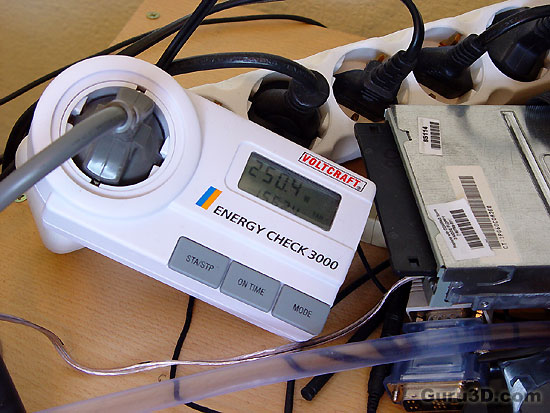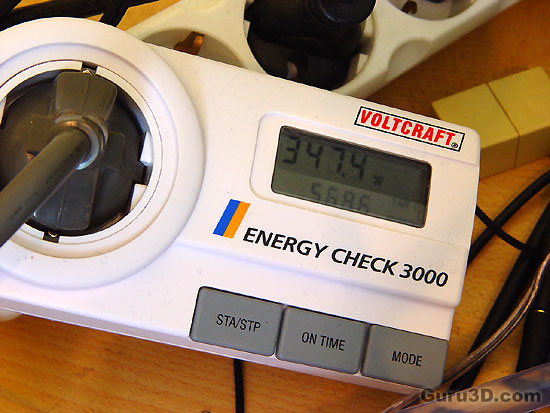Page 4
Power Supply - Watt Did You Say?![]()
The dreaded word in the industry: power consumption.
The GeForce 7600GT/7900GT & 7900 GTX requires a very stable 12-volt power source for best performance, reliability and most of all that gaming experience of yours.For a GeForce 7900 GT or GTX graphics card, NVIDIA recommends a 350-400 watt power supply with 22-26 ampere on the 12 volts rails. So NVIDIA is recommending nothing too theatrical in terms of wattage for the power supply unit, yet be aware as that's a lot of Ampage on the 12 volts rails. What we always do with new graphics' cards, we measure the wattage peak with the help of a wattage meter. Slight side note, you are looking at the overall usage of the entire PC. The meter is placed between the power connector and the PSU. So please understand that using a Wattage meter is not the most reliable way of measuring power consumption. You basically look at how much power is the power circuit from your house pulling from the PSU. So you need to look at the results as being an indication and not an exact science.
Let's have a look at the three products
| Card | PC Power Consumption in Watt |
| GeForce 7600 GT | 198 |
| GeForce 7900 GT | 235 |
| GeForce 7900 GTX | 255 |
| GeForce 7600 GT (SLI) | 274 |
| GeForce 7900 GT (SLI) | 335 |
| GeForce 7900 GTX (SLI) | 360 |
The methodology: we simply look at the peak Wattage during a 3DMark05 session to verify power consumption. You are not looking at the power consumption of the graphics card, but of the entire PC.
The 7900 GTX graphics card for example consumes roughly 120 Watts at peak during 3D gaming.

A single GeForce 7900 GTX 512 MB with the rest of the components in the PC used up-to 255 Watts.

But once you choose SLI a 350-360 Watts peak is not so strange at all.
So indeed, you need 350 at the least as you want some spare wattage and 420 Watts or better is definitely recommended. When you buy a new PSU then look at the packaging and check the 12 volts rail on Ampere, it should be 22 AMPS minimal.
SLI is an entirely different ballgame.
There are some good SLI certified PSU's out there, these have dual 12 volts rails dedicated for the graphics card. We highly recommend them! In fact we'll test some of them in the very near future.What would happen if your PSU can't cope with the load?:
- bad 3D performance
- crashing games
- spontaneous resetting PC
- freezes during gameplay
- PSU overload can cause it to break down
So many things can happen.
Dangerous Liaisons - temperatures of the graphics cardBoth the 7600 GT and 7900 GT products have a very similar looking single slot cooler. Pure reference of course, yet it's working quite well. The 7900 GTX then, I stated it in the 7800 GTX review already, I just love that heat-pipe design cooler. It's just so efficient and silent. This card uses the same heatpipe cooler as the reference model we recently tested on the 7800 GTX 512MB.
Let's have a look at the temperatures these cards produce.
| Card | Temperature in idle (Celsius) | Temperature at 100% load in (Celsius) |
| GeForce 7600 GT | 39 | 65 |
| GeForce 7900 GT | 42 | 68 |
| GeForce 7900 GTX | 44 | 73 |
A maximum 73 Degrees C peak temperature was monitored at the 7900 GTX, it is actually becoming the norm. Ventilation, the cooling fan at 100% utilization does not make a lot of noise at all on all cards though, in fact the HD is producing way more noise then the reference coolers on these NVIDIA graphics card and that's very nice to observe. The 7900 GTX however is the most silent thanks to that nice heatpipe-cooler.
Both the 7600 GT & 7900 GT show very acceptable temperature levels at roughly 65 Degrees C.
Noise Levels coming from the graphics cardNauseating is the noise that PC's these days produce. The only way that will change that is if we all will pay attention to it.
When graphics cards produce a lot of heat usually that heat needs to be transported away from the hot core as fast as possible. Often you'll see massive active fan solutions that can indeed get rid of the heat, yet all the fans these days make the PC a noisy son of a gun. I'm doing a little try out today with noise monitoring, so basically the test we do is extremely subjective. We bough a certified dBA meter and will start measuring how many dBA originate from the PC. Why is this subjective you ask? Well, there is always noise in the background, from the streets, from the HD, PSU fan etc etc, so this is by a mile or two not a precise measurement. You could only achieve objective measurement in a sound test chamber.
The human hearing system has different sensitivities at different frequencies. This means that the perception of noise is not at all equal at every frequency. Noise with significant measured levels (in dB) at high or low frequencies will not be as annoying as it would be when its energy is concentrated in the middle frequencies. In other words, the measured noise levels in dB will not reflect the actual human perception of the loudness of the noise. That's why we measure the dBa level. A specific circuit is added to the sound level meter to correct its reading in regard to this concept. This reading is the noise level in dBA. The letter A is added to indicate the correction that was made in the measurement.
|
TYPICAL SOUND LEVELS | ||
|
Jet takeoff (200 feet) |
120 dBA |
|
|
Construction Site |
110 dBA |
Intolerable |
|
Shout (5 feet) |
100 dBA |
|
|
Heavy truck (50 feet) |
90 dBA |
Very noisy |
|
Urban street |
80 dBA |
|
|
Automobile interior |
70 dBA |
Noisy |
|
Normal conversation (3 feet) |
60 dBA |
|
|
Office, classroom |
50 dBA |
Moderate |
|
Living room |
40 dBA |
|
|
Bedroom at night |
30 dBA |
Quiet |
|
Broadcast studio |
20 dBA |
|
|
Rustling leaves |
10 dBA |
Barely audible |
We startup a benchmark, we take the dBA meter, move away 75 CM and then aim the device at the active fan on the graphics card.
| Card | Sound Level in measured inDBa |
| GeForce 7600 GT | 48 |
| GeForce 7900 GT | 50 |
| GeForce 7900 GTX | 44 |
We measure roughly 44 dBa on the fastest product, which is to be considered a quiet to moderate noise level coming from the PC. Again, this is a very subjective test. Nonetheless it's a very good outcome for NVIDIA though as that's a really acceptable level for all cards.
